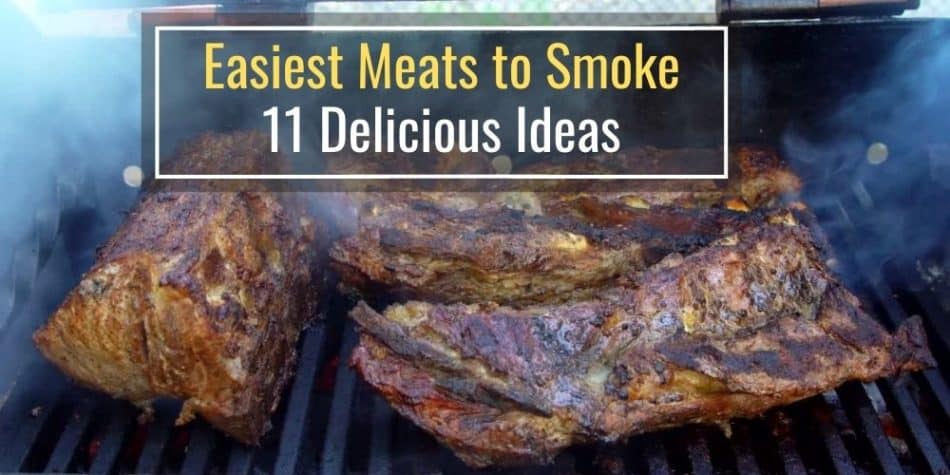Whether you just got into smoking or have been smoking for a long time, this list will help you explore some easy and delicious meats that you should try smoking.
Generally, fatty cuts of meat that are tough do the best with smoking. The low and slow smoking process will soften the tough meat and allow the fat to spread throughout the meat.
However, there are some cuts of meat that are easier to smoke than others.
Now let’s dive into the easiest meats to smoke and we’ll also provide our recommendation on how best to smoke each meat.
1. Pulled Pork
Pulled pork is one of the best and easiest meats to smoke. Even if you’ve made pulled pork using a crockpot or pressure cooker, smoked pulled pork is something else entirely!
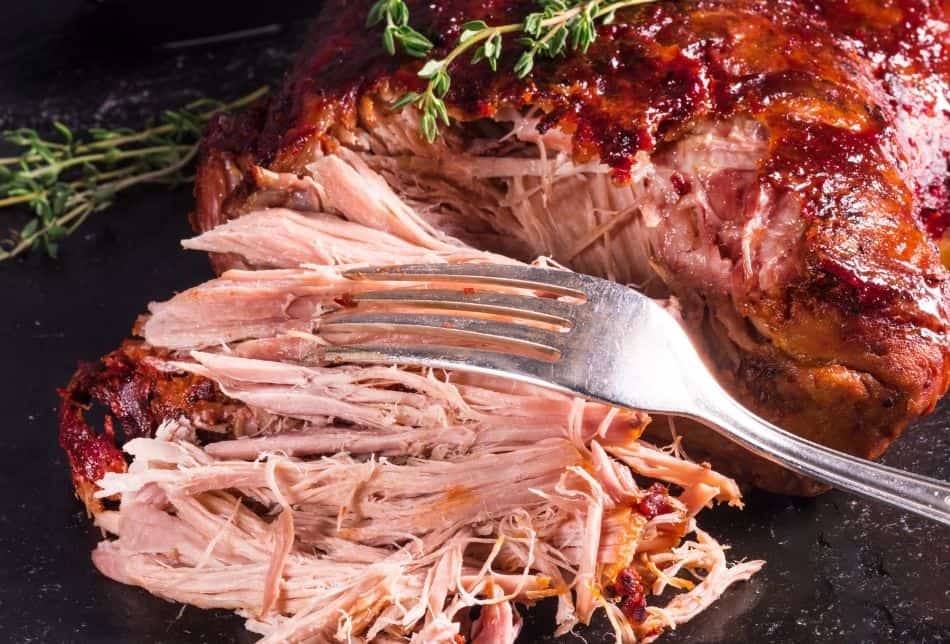
Pork shoulder or Boston butt are both fatty cuts of pork that can be smoked into pulled pork. The benefit of using fatty cuts of meat when smoking is that the meat is more forgiving and will likely not dry out.
Not to mention pork tends to be cheaper compared to other meats so this is a great one to make when smoking for the first few times.
See this guide for smoking pulled pork at 225 degrees Fahrenheit which will help ensure you’re left with juicy pulled pork.
Below are the main steps for smoking pulled pork.
Smoking Pulled Pork
First, use mustard as a binder and rub the mustard all over the pork shoulder. Next, use your favorite BBQ seasoning and thoroughly coat the pork shoulder.
We recommend smoking the pork shoulder or boston butt at 225 degrees Fahrenheit for 1.5 hours per pound. So an 8-pound pork shoulder will take about 12 hours to smoke.
Always use a thermometer to measure the internal temperature of the meat and take the pulled pork off the smoker when the internal temperature reaches 200 to 205 degrees Fahrenheit.
You can wrap the pork in butcher paper or foil halfway through the smoke if you want to speed up the cooking. However, the pork will cook just fine unwrapped if you want to make it as easy as possible.
Once the pulled pork is cooked, wrap the meat with foil and place the wrapped pork in a cooler to allow the meat to rest. After 1 hour, the pork will literally fall apart and you can easily remove the bone by twisting and pulling.
2. Beef Brisket
Beef brisket is one of THE meats that everyone wants to cook when you first start smoking.
Brisket is one of those meats that defines BBQ and is difficult to cook unless you have a smoker.
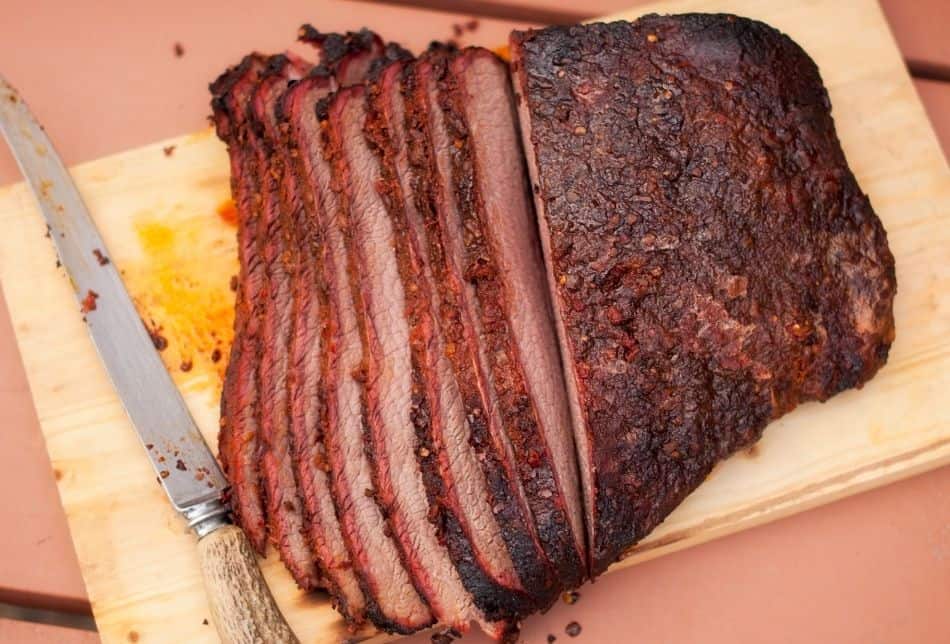
The good news is that brisket is not hard to smoke – brisket just takes a lot of time.
Beef brisket is another fatty cut of meat that is forgiving when smoked.
However, beef brisket does benefit from a little bit of prep including trimming the excess fat.
Smoking Beef Brisket
Unlike pork, beef brisket does not need a binder. First, trim the excess fat off the brisket and try to make the brisket as even in thickness as possible. See this brisket trimming guide for perfect juicy slices.
Next, pat the brisket dry of any excess moisture before thoroughly seasoning the brisket.
We recommend smoking the brisket at 225 degrees Fahrenheit for 1.5 to 2 hours per pound. So a 10-pound brisket will take about 15 to 20 hours to smoke.
Always use a thermometer to measure the internal temperature of the meat and take the brisket off the smoker when the internal temperature reaches 165 degrees Fahrenheit and wrap the brisket in butcher paper.
Place the wrapped brisket back on the smoker and wait until the internal temperature reaches 200 to 205 degrees Fahrenheit to pull the brisket from the smoker.
Place the wrapped and cooked brisket in a cooler and allow the meat to rest for 1 to 2 hours.
The rested brisket will be juicy and ready to slice.
3. Pork Ribs
Pork ribs are another easy and great meat to smoke. Whether you use baby back ribs, st. louis ribs, or spare ribs, pork ribs are some of the tastiest meat to smoke.
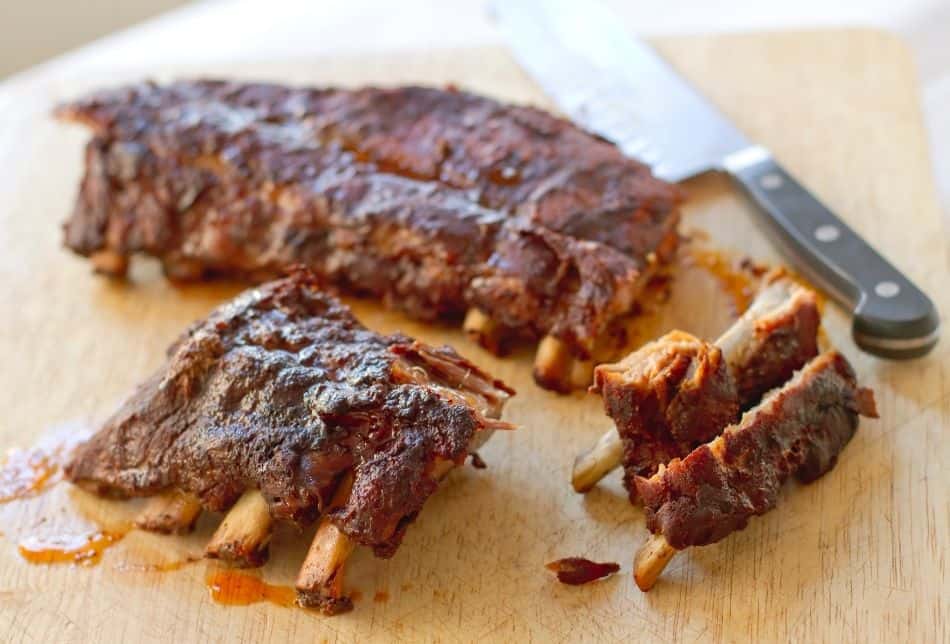
Pork ribs are another fatty cut of meat that usually have the fat marbled in with the meat.
You do not need to do much work to prep ribs which makes these a great choice when you’re wanting to smoke something easy.
Smoking Pork Ribs
Similar to pork shoulder, pork ribs also benefit from using a binder like mustard before seasoning. The mustard will help hold all the seasoning onto the ribs.
Make sure to season the ribs thoroughly on both sides before placing the ribs directly on the smoker.
We recommend smoking the pork ribs at 225 degrees Fahrenheit with the 3-2-1 method. So any size and amount of pork ribs will be ready in 6 hours following the 3-2-1 method.
First smoke the ribs unwrapped on the smoker for 3 hours.
After 3 hours, take the ribs off the smoker and wrap them in aluminum foil. You can add butter, brown sugar, and other seasonings to the ribs before crimping the foil together.
Place the wrapped ribs back on the smoker for 2 hours.
After 2 hours, take the wrapped ribs off the smoker and unwrap the foil. Remove the ribs from the foil and place the ribs bone side down back on the smoker.
Brush the ribs with your favorite BBQ sauce and allow the sauce to carmelize in the final 1 hour of smoking.
Remove the sauced and smoked ribs from the smoker and allow the ribs to rest for 15 to 30 minutes before cutting into the ribs and serving.
4. Whole Chicken
Another easy and cheap meat to smoke is a whole chicken. Smoking a chicken will make you appreciate how good a chicken can taste when a little extra smoke flavor is added to this meat.
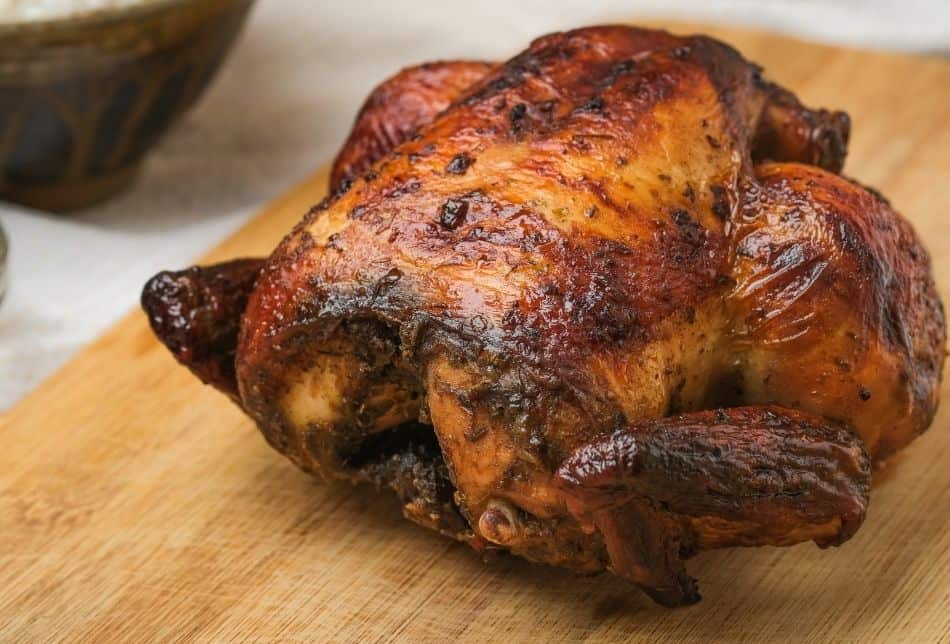
Chicken is a much leaner cut of meat compared to pork or beef so the chicken can dry out if you’re not paying attention.
However, there are a few methods for helping the chicken stay moist.
Smoking Whole Chicken
For chicken, I prefer to use olive oil as a binder before seasoning the chicken thoroughly on all sides.
You can place stuffing in the chicken or season the inside chicken if you want.
Use butcher twine to tie the legs together and tuck the wing tips behind the shoulder joint. Keeping the chicken compact will ensure that the legs and wings do not cook too fast and dry out so do not skip this step!
Place the chicken directly on the smoker and smoke for 4 hours at 225 degrees Fahrenheit.
During the final 30 minutes, baste the outside of the chicken with your favorite BBQ sauce or liquid seasoning if you want.
If you want crispy skin on your chicken, make sure to increase the heat of the smoker to 350 or 400 degrees Fahrenheit for the final 30 minutes of smoking the chicken.
Always use a thermometer when smoking chicken and pull the chicken off the smoker when the chicken breasts reach an internal temperature of 165 degrees Fahrenheit.
After removing the chicken from the smoker, allow the chicken to rest for 30 minutes before cutting into it and serving.
5. Tomahawk Steak
The iconic tomahawk steak is essentially a ribeye with a nice long bone attached.
Surprisingly, smoking a steak can make it taste better especially when you reverse sear the steak.
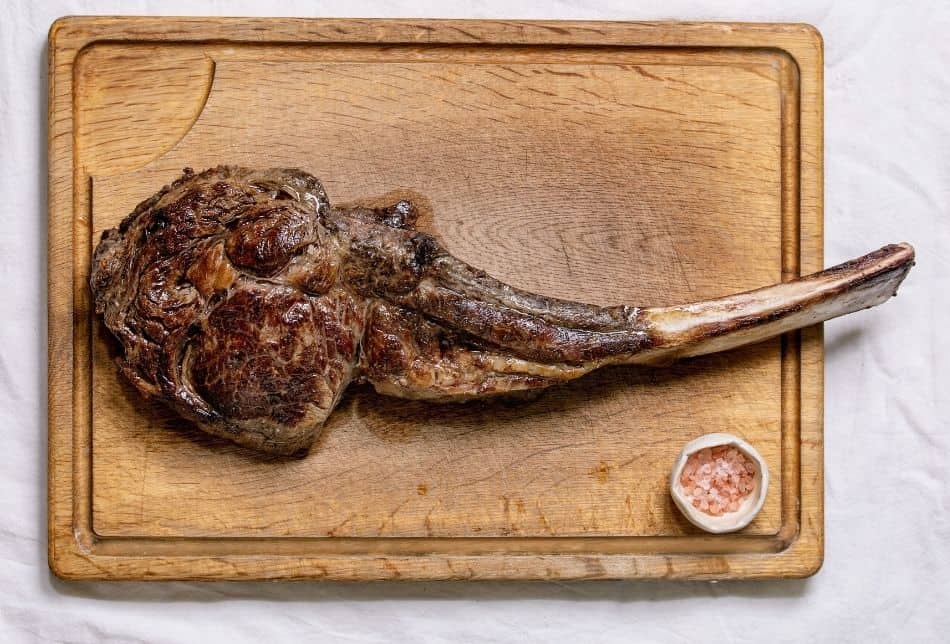
Steaks that have a good amount of marbling such as tomahawk and ribeye steaks will taste even better in a smoker.
The smoke will allow the fats to render down and slowly spread throughout the meat.
Not to mention the added smoke flavor is a nice touch.
Smoking Tomahawk Steaks
Generally, steaks do not require binders such as olive oil or mustard before seasoning.
Most of the time, the seasoning will stick just fine to the steak. So grab just salt and pepper or your favorite seasoning mix and thoroughly coat both sides of the steak.
Place the steak on the smoker at 225 degrees Fahrenheit and wait until the internal temperature of the steak reaches 125 degrees Fahrenheit.
Once the steak hits 5 to 10 degrees below your desired internal temperature or steak doneness, remove the steak from the smoker.
Reverse searing a steak is where you smoke the steak first and then sear the steak at the end.
So after removing the steak from the smoker, increase the cooking temperature of the smoker to 400 degrees Fahrenheit. Place the steak back on the smoker for 2 to 3 minutes per side until the steak develops nice sear marks.
The steak will also cook a little more when searing so your steak should reach your desired doneness.
After removing the steak from the smoker, allow the steak to rest for 10 to 15 minutes before cutting the steak.
6. Chicken Breast
Chicken breasts are a great cut of chicken to smoke since smoking will add a ton of flavor.
However, chicken breasts are known to dry out easily so some preventative steps should be taken to ensure the chicken breasts remain moist.
Smoking Chicken Breast
Chicken breasts are usually skinless and boneless so you will need to use a binder such as olive oil before seasoning the chicken.
Make sure to thoroughly season both sides of the chicken.
Place the chicken breasts on the smoker at 225 degrees Fahrenheit and smoke for approximately 1 hour.
Make sure to use a thermometer to pull the chicken breasts off the smoker as soon as the internal temperature reaches 160 degrees Fahrenheit.
After removing the chicken breasts from the smoker, wrap the chicken breasts in foil and allow the chicken to rest which will also cook the chicken to 165 degrees Fahrenheit.
Allow the chicken breasts to rest for 30 minutes before cutting and serving.
Two tips on keeping chicken breasts moist when smoking are:
- Place a water pan in the smoker with the chicken breasts
- Brine the chicken breasts before placing them on the smoker
7. Whole Turkey
Similar to smoking a whole chicken, smoking a whole turkey is a great way to cook an entire bird.
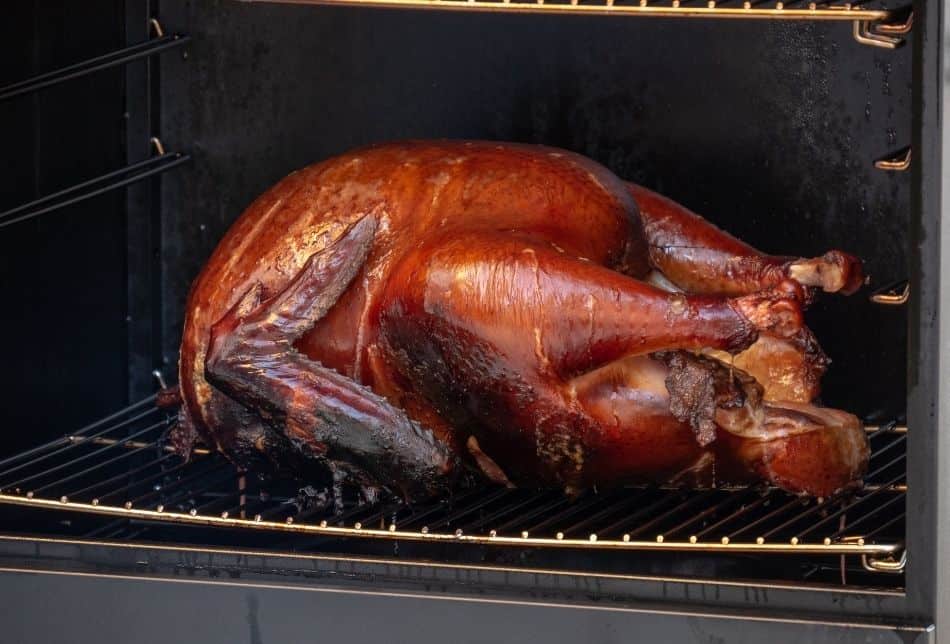
Although turkey tends to be drier meat to smoke, there are ways to ensure that the turkey stays moist throughout the smoke.
Not to mention the added smoke flavor will make any turkey taste much better.
Smoking Whole Turkey
First, place the turkey in an aluminum pan and tuck the wings under the body.
Next stuff the cavity of the turkey with onions, lemons, herbs, and any other stuffing you like. Use kitchen twine to tie the legs together to help close the cavity.
Before coating the outside of the turkey with your favorite BBQ seasoning rub, make sure to use a binder such as olive oil to help hold all the seasoning to the turkey.
Place the whole turkey in the smoker at 225 degrees Fahrenheit and allow the turkey to cook for 6 to 8 hours. Baste the turkey with chicken broth every hour.
Use a thermometer to measure the internal temperature of the thickest part of the turkey and pull the turkey off the smoker as soon as the internal temperature reaches 165 degrees Fahrenheit.
After removing the turkey from the smoker, cover the turkey with foil and allow the turkey to rest 30 minutes before cutting and serving.
If you like to eat crispy turkey skin then you will want to increase the temperature of the smoker to 400 degrees Fahrenheit for the final 10 minutes of cooking the turkey.
8. Sausage
Any sausage is a great beginner-friendly meat to smoke given how easy sausage is to smoke.
Whether you use bratwurst, hot dogs, or your favorite butcher’s blend, sausages cooked on the smoker will have a nice smoky flavor.
Smoking Sausages
Sausages do not need to be seasoned before being placed on the smoker which is great compared to other cuts of meat.
Place the sausages onto the smoker at 225 degrees Fahrenheit and allow the sausages to smoke for 3 to 4 hours.
Use a thermometer to measure the internal temperature of the sausages and pull the sausages once the internal temperature of the sausages reaches 165 degrees Fahrenheit.
Allow the sausages to rest for 10 minutes before serving.
9. Chicken Wings
Chicken wings are a great beginner-friendly meat to smoke given how quick and easy to smoke they are.
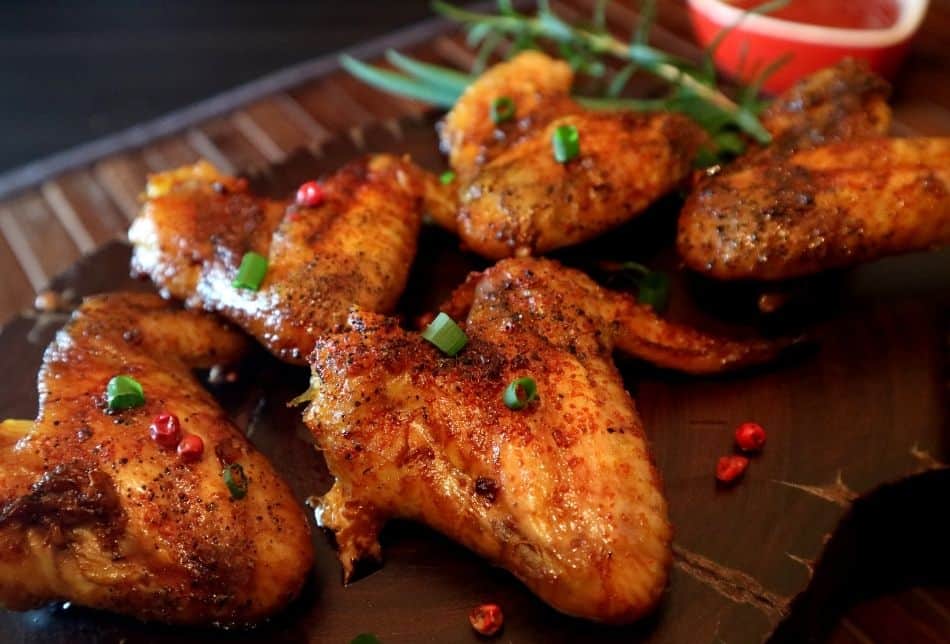
Usually, chicken wings only take about 2 hours to smoke so these can be ready at a moment’s notice if you have surprise guests.
Although chicken wings are commonly fried, baked, or grilled, smoking chicken wings will add a nice smoky flavor to your favorite finger food.
Smoking Chicken Wings
You can smoke whole chicken wings or split the chicken wings up into flats and drums.
Regardless of how you cut up the chicken wings, make sure to toss all of the chicken wings in a big bowl with a bit of olive oil before thoroughly seasoning the wings.
Generally, you will want to use a dry rub when first seasoning the wings since you can baste the wings with your favorite sauce on the smoker as the chicken wings are finishing.
Place the chicken wings on the smoker at 225 degrees Fahrenheit for 1 hour. Remove the chicken wings from the smoker and increase the cooking temperature to 400 degrees Fahrenheit.
Once the smoker reaches 400 degrees Fahrenheit, place the chicken wings back on the smoker and use a thermometer to check the wings.
Baste the chicken wings with your favorite wing sauce and keep the wings on the smoker until the wings reach an internal temperature of 165 degrees.
Remove the wings from the smoker and serve immediately. You can also toss the wings in a bowl of sauce one final time if you prefer to have extra saucy wings.
10. Burgers
Hamburgers are one of those common grilling foods that many folks overlook when it comes to smoking.
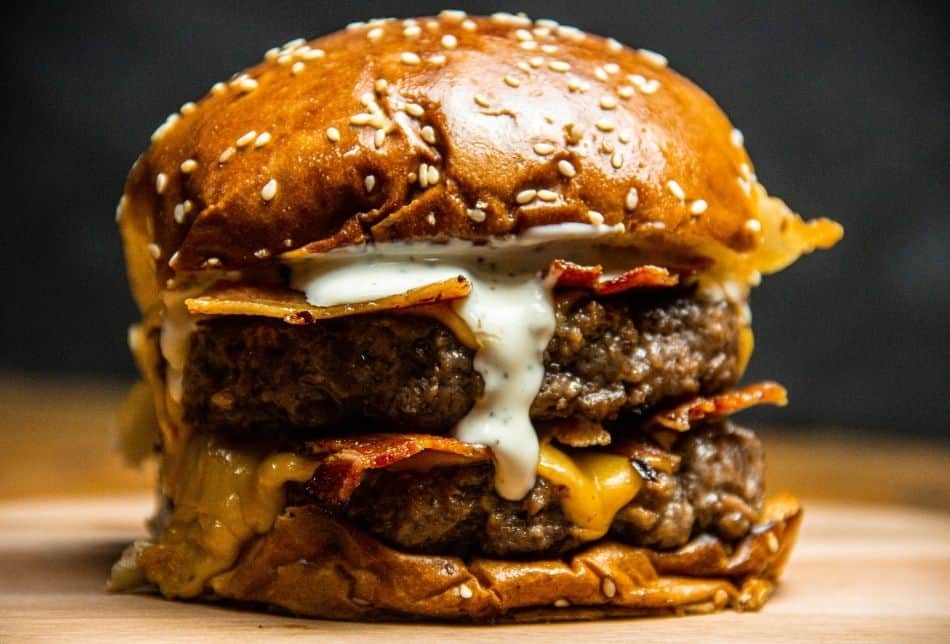
Although hamburgers are great for grilling, burgers are also great for smoking.
Smoking a hamburger will add a great smoky flavor since the ground beef is so porous.
Not to mention, smoking a hamburger is quick and easy since it only takes about 1 hour to smoke a burger.
Smoking Hamburgers
First, shape your ground beef into patties about 1/2 inch larger in diameter than the burger buns.
Use your favorite burger seasoning blend on the burger patties.
Place the seasoned patties on the smoker at 225 degrees Fahrenheit and allow the burgers to smoke for about 1 hour.
Use a thermometer and remove the burger patties from the smoker when the burgers reach an internal temperature of 125 degrees.
Increase the cooking temperature of the smoker to 400 degrees Fahrenheit and place the burgers back on the smoker.
Allow the burgers to sear for 2-3 minutes per side and add cheese to the top of the patties after the patties are flipped.
Use a thermometer and remove the burger patties from the smoker when they reach your desired doneness.
Generally, burgers will be medium-rare at around 130 degrees Fahrenheit while a burger will be well-done at around 160 degrees Fahrenheit.
Assemble your burger with your smoked patties and favorite toppings.
Here’s a video where I smoke hamburgers for the first time:
11. Salmon
Salmon is meat that can be slow-smoked over multiple hours to create salmon jerky or quickly smoked to create a delicious smoked salmon fillet.
We’ll cover how to quickly smoke a salmon since it’s much easier to smoke salmon for about 1 hour.
Smoking Salmon
In order to create a delicious smoked salmon fillet, you should dry brine the salmon fillet first.
Place the salmon fillet on a baking sheet and create a dry brining mixture of salt, white sugar, and brown sugar.
Thoroughly coat both sides of the salmon fillet with the brining mixture and allow the salmon to brine for about 30 minutes in the fridge.
Next, rinse off the dry brine mixture with cold water and pat the fillet dry.
Coat the salmon fillet with olive oil and thoroughly season the salmon fillet with your favorite fish seasoning.
Place the seasoned salmon fillet on the smoker at 225 degrees Fahrenheit for about 1 hour.
Occasionally check on the salmon to see if the salmon has reached your desired doneness by poking and flaking the salmon flesh with a fork.
After removing the salmon from the smoker, allow the salmon to rest for 10 minutes before serving. You can also use a maple glaze or lemon juice before serving to add extra moisture to the smoked salmon.
Tips For Smoking Meat
Before smoking meat for the first time, here are some tips that will help you when smoking meat.
These are general guidelines that will always apply to smoking meat whether you’re a beginner or an expert.
Low and Slow
Smoking meat is best done “low and slow.”
Low means that you should use a low cooking temperature such as 225 degrees Fahrenheit since most smokers will produce more smoke at lower cooking temperatures.
Not to mention, lower temperatures are better for transforming a tough hunk of meat into fall-off-the-bone goodness.
Next, slow refers to how long the meat will take to smoke. Generally, you want to smoke meat slowly so that the meat has a chance to absorb more smoky flavor.
If you place the meat on a smoker for only 5 minutes, the meat will not taste very smoky.
However, meat that is allowed to smoke for 7 hours on a smoker will have a much stronger smoky flavor.
Start Earlier Than You Initially Planned
Given that you should smoke meat “low and slow” on a smoker, you should always start smoking earlier than you initially planned.
Prepping and seasoning the meat may take longer than expected.
Not to mention, sometimes the same cut of meat will take longer to smoke one day versus a previous day due to the thickness of the meat, weather, or some other reason.
So always start smoking earlier than you expect so you have extra time to finish smoking the meat before meal time.
Plus smoked meat will always taste better when allowed to rest. Resting meat allows the meat to reabsorb the moisture and the smoke flavor will be more noticeable once the meat has cooled down.
More Smoke Isn’t Always Better
Sometimes too much of a good thing can be a bad thing and the same rule applies to smoke.
Too much smoke is actually bad since the meat will develop an acrid flavor.
Generally, you want to have a thin bluish-gray smoke coming from the smoker so the meat is being hit with the right blend of air and smoke.
Ways To Create More Good Smoke
The best way to create more good smoke is by adjusting the fuel to air ratio in the smoker.
If you have too much wood in the smoker then there will be thick white smoke pouring out of the smoker. This is bad smoke.
When you allow more air to feed into the smoker then you should see a nice light-colored smoke coming from the smoker. This is good smoke.
Generally, pellet smokers will be able to produce good smoke since the convection fan will ensure that the wood pellets are burning cleanly.
Keep The Lid Closed
When smoking meat, the meat needs to smoke low and slow.
So keep the lid closed at all times.
Try to avoid checking or looking at the meat as it smokes since this will allow all of the hot air and smoke to escape from the smoker.
Then the smoker will need to create more smoke and heat to come up to cooking temperature.
The meat needs consistent heat over a long period of time to tenderize the tough parts of the meat.
Rest Before Eating Smoked Meat
Resting the meat is one of the most important and overlooked steps when smoking.
Even if you do everything right and smoke the perfect brisket, if you cut into the brisket as soon as it comes off the smoker then you’ll be left with a very dry brisket after all the juices pour out.
Allowing the meat to rest will give the meat a chance to reabsorb all of the juices in the meat.
Not to mention, meat will taste smokier once the meat is allowed to rest.
So make sure to give the smoked meat enough time to rest before slicing into it.

